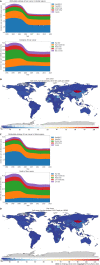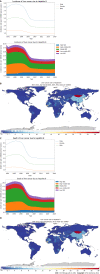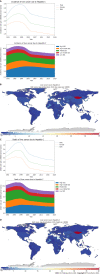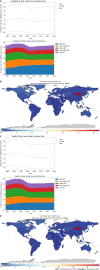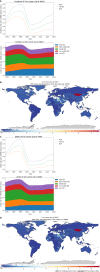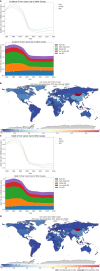Socioeconomics and attributable etiology of primary liver cancer, 1990-2019 - PubMed (original) (raw)
Socioeconomics and attributable etiology of primary liver cancer, 1990-2019
Qing-Qing Xing et al. World J Gastroenterol. 2022.
Abstract
Background: Primary liver cancer (PLC) is a major contributor to cancer-related deaths. Data on global and country-specific levels and trends of PLC are essential for understanding the effects of this disease and helping policymakers to allocate resources.
Aim: To investigate the association between the burden of PLC and socioeconomic development status.
Methods: Cancer mortality and incidence rates were obtained from the Global Burden of Disease (GBD) 2019, and the data were stratified by country and territory, sex, and the Socio-demographic Index (SDI) level. The association between the attributable etiology of PLC and socioeconomic development status, represented using the SDI, was described. The attributable etiology of PLC included hepatitis B, hepatitis C, alcohol use, and nonalcoholic steatohepatitis. The association between the attributable etiology of PLC and SDI was further stratified by sex and geographical location. A confidence analysis was also performed based on bootstrap draw.
Results: The age-standardized incidence rate of PLC was 6.5 [95% confidence intervals (CI): 5.9-7.2] per 100000 person-years, which decreased by -27.5% (-37.0 to -16.6) from 1990 to 2019. Several countries located in East Asia, South Asia, West Africa, and North Africa shouldered the heaviest burden of PLC in 2019. In terms of incidence rates, the first leading underlying cause of PLC identified was hepatitis B, followed by hepatitis C, alcohol use, and nonalcoholic steatohepatitis. Regarding stratification using the SDI, the incidence rate of PLC was the highest for high and middle SDI locations. Further, the leading attributable etiologies of PLC were hepatitis B for the middle and high middle SDI locations while hepatitis C and nonalcoholic steatohepatitis for the high SDI locations.
Conclusion: The pronounced association between socioeconomic development status and PLC burden indicates socioeconomic development status affects attributable etiologies for PLC. GBD 2019 data are valuable for policymakers implementing PLC cost-effective interventions.
Keywords: Alcohol; Epidemiology; Hepatitis; Primary liver cancer; Public health; Socioeconomics.
©The Author(s) 2022. Published by Baishideng Publishing Group Inc. All rights reserved.
Conflict of interest statement
Conflict-of-interest statement: All authors report no conflicts interests.
Figures
Figure 1
Burden of liver cancer for 204 countries and territories. A and C: Age-standardized incidence (A) and death (C) rates per 100000 population for liver cancer from 1990 through 2019, stratified by the attributable etiology of liver cancer or the Socio-demographic Index; B and D: Age-standardized incidence (B) and death (D) rate of liver cancer per 100000 person-years by country and territory, in 2019. The maps in (B) and (D) are generated using the Global Burden of Disease 2019 tool. SDI: Socio-demographic Index; NASH: Nonalcoholic steatohepatitis.
Figure 2
Burden of liver cancer caused by hepatitis B for 204 countries and territories. A and C: Age-standardized incidence (A) and death (C) rates per 100000 population of liver cancer caused by hepatitis B from 1990 through 2019, stratified by sex or the Socio-demographic Index; B and D: Age-standardized incidence (B) and death (D) rate of liver cancer caused by hepatitis B per 100000 person-years by country and territory, in 2019. The maps in (B) and (D) are generated using the Global Burden of Disease 2019 tool. SDI: Socio-demographic Index.
Figure 3
Burden of liver cancer caused by hepatitis C for 204 countries and territories. A and C: Age-standardized incidence (A) and death (C) rate per 100000 population of liver cancer caused by hepatitis C from 1990 through 2019, stratified by sex or the Socio-demographic Index; B and D: Age-standardized incidence (B) and death (D) rate of liver cancer caused by hepatitis C per 100000 person-years by country and territory, in 2019. The maps in (B) and (D) are generated using the Global Burden of Disease 2019 tool. SDI: Socio-demographic Index.
Figure 4
Burden of liver cancer attributed to alcohol use for 204 countries and territories. A and C: Age-standardized incidence (A) and death (C) rate per 100000 population of liver cancer attributed to alcohol use from 1990 through 2019, stratified by sex or the Socio-demographic Index; B and D: Age-standardized incidence (B) and death (D) rate of liver cancer attributed to alcohol use per 100000 person-years by country and territory, in 2019. The maps in (B) and (D) are generated using the Global Burden of Disease 2019 tool. SDI: Socio-demographic Index.
Figure 5
Burden of liver cancer attributed to nonalcoholic steatohepatitis for 204 countries and territories. A and C: Age-standardized incidence (A) and death (C) rate per 100000 population of liver cancer attributed to nonalcoholic steatohepatitis (NASH) from 1990 through 2019, stratified by sex or the Socio-demographic Index; B and D: Age-standardized incidence (B) and death (D) rate of liver cancer attributed to NASH per 100000 person-years by country and territory, in 2019. The maps in (B) and (D) are generated using the Global Burden of Disease 2019 tool. SDI: Socio-demographic Index.
Figure 6
Burden of liver cancer attributed to other causes for 204 countries and territories. A and C: Age-standardized incidence (A) and death (C) rate per 100000 population of liver cancer attributed to other cause from 1990 through 2019, stratified by sex or the Socio-demographic Index; B and D: Age-standardized incidence (B) and death (D) rate of liver cancer attributed to other causes per 100000 person-years by country and territory, in 2019. The maps in (B) and (D) are generated using the Global Burden of Disease 2019 tool. SDI: Socio-demographic Index.
Similar articles
- Global, Regional, and National Trends in Incidence and Mortality of Primary Liver Cancer and Its Underlying Etiologies from 1990 to 2019: Results from the Global Burden of Disease Study 2019.
Cao G, Liu J, Liu M. Cao G, et al. J Epidemiol Glob Health. 2023 Jun;13(2):344-360. doi: 10.1007/s44197-023-00109-0. Epub 2023 May 13. J Epidemiol Glob Health. 2023. PMID: 37178451 Free PMC article. - Global burden of acute viral hepatitis and its association with socioeconomic development status, 1990-2019.
Zeng DY, Li JM, Lin S, Dong X, You J, Xing QQ, Ren YD, Chen WM, Cai YY, Fang K, Hong MZ, Zhu Y, Pan JS. Zeng DY, et al. J Hepatol. 2021 Sep;75(3):547-556. doi: 10.1016/j.jhep.2021.04.035. Epub 2021 May 4. J Hepatol. 2021. PMID: 33961940 - The global burden of disease attributable to high body mass index in 195 countries and territories, 1990-2017: An analysis of the Global Burden of Disease Study.
Dai H, Alsalhe TA, Chalghaf N, Riccò M, Bragazzi NL, Wu J. Dai H, et al. PLoS Med. 2020 Jul 28;17(7):e1003198. doi: 10.1371/journal.pmed.1003198. eCollection 2020 Jul. PLoS Med. 2020. PMID: 32722671 Free PMC article. - The Global Burden of Liver Disease.
Younossi ZM, Wong G, Anstee QM, Henry L. Younossi ZM, et al. Clin Gastroenterol Hepatol. 2023 Jul;21(8):1978-1991. doi: 10.1016/j.cgh.2023.04.015. Epub 2023 Apr 28. Clin Gastroenterol Hepatol. 2023. PMID: 37121527 Review. - Changing epidemiology of hepatocellular carcinoma in Asia.
Goh GB, Chang PE, Tan CK. Goh GB, et al. Best Pract Res Clin Gastroenterol. 2015 Dec;29(6):919-28. doi: 10.1016/j.bpg.2015.09.007. Epub 2015 Sep 10. Best Pract Res Clin Gastroenterol. 2015. PMID: 26651253 Review.
Cited by
- Global, regional, and national burden of intestinal obstruction from 1990 to 2019: an analysis from the Global Burden of Disease Study 2019.
Long D, Mao C, Liu Y, Zhou T, Xu Y, Zhu Y. Long D, et al. Int J Colorectal Dis. 2023 Oct 3;38(1):245. doi: 10.1007/s00384-023-04522-6. Int J Colorectal Dis. 2023. PMID: 37787806 - The Association between Statins and Liver Cancer Risk in Patients with Heart Failure: A Nationwide Population-Based Cohort Study.
Lu MC, Chen CC, Lu MY, Lin KJ, Chiu CC, Yang TY, Fang YA, Jian W, Chen MY, Hsu MH, Lai YH, Yang TL, Hao WR, Liu JC. Lu MC, et al. Cancers (Basel). 2023 May 29;15(11):2959. doi: 10.3390/cancers15112959. Cancers (Basel). 2023. PMID: 37296921 Free PMC article. - Global, Regional, and National Trends in Incidence and Mortality of Primary Liver Cancer and Its Underlying Etiologies from 1990 to 2019: Results from the Global Burden of Disease Study 2019.
Cao G, Liu J, Liu M. Cao G, et al. J Epidemiol Glob Health. 2023 Jun;13(2):344-360. doi: 10.1007/s44197-023-00109-0. Epub 2023 May 13. J Epidemiol Glob Health. 2023. PMID: 37178451 Free PMC article. - Estimates and trends of the global burden of NASH-related liver cancer attributable to high fasting plasma glucose in 1990-2019: analysis of data from the 2019 Global Burden of Disease Study.
Li Z, Yang N, He L, Wang J, Ping F, Li W, Xu L, Zhang H, Li Y. Li Z, et al. Diabetol Metab Syndr. 2023 Jan 17;15(1):6. doi: 10.1186/s13098-022-00976-w. Diabetol Metab Syndr. 2023. PMID: 36647090 Free PMC article. - Imaging based body composition profiling and outcomes after oncologic liver surgery.
Bernardi L, Roesel R, Vagelli F, Majno-Hurst P, Cristaudi A. Bernardi L, et al. Front Oncol. 2022 Dec 8;12:1007771. doi: 10.3389/fonc.2022.1007771. eCollection 2022. Front Oncol. 2022. PMID: 36568174 Free PMC article. Review.
References
- Sung H, Ferlay J, Siegel RL, Laversanne M, Soerjomataram I, Jemal A, Bray F. Global Cancer Statistics 2020: GLOBOCAN Estimates of Incidence and Mortality Worldwide for 36 Cancers in 185 Countries. CA Cancer J Clin. 2021;71:209–249. - PubMed
- Chen W, Zheng R, Baade PD, Zhang S, Zeng H, Bray F, Jemal A, Yu XQ, He J. Cancer statistics in China, 2015. CA Cancer J Clin. 2016;66:115–132. - PubMed
- Siegel RL, Miller KD, Fuchs HE, Jemal A. Cancer Statistics, 2021. CA Cancer J Clin. 2021;71:7–33. - PubMed
- Global Burden of Disease Liver Cancer Collaboration, Akinyemiju T, Abera S, Ahmed M, Alam N, Alemayohu MA, Allen C, Al-Raddadi R, Alvis-Guzman N, Amoako Y, Artaman A, Ayele TA, Barac A, Bensenor I, Berhane A, Bhutta Z, Castillo-Rivas J, Chitheer A, Choi JY, Cowie B, Dandona L, Dandona R, Dey S, Dicker D, Phuc H, Ekwueme DU, Zaki MS, Fischer F, Fürst T, Hancock J, Hay SI, Hotez P, Jee SH, Kasaeian A, Khader Y, Khang YH, Kumar A, Kutz M, Larson H, Lopez A, Lunevicius R, Malekzadeh R, McAlinden C, Meier T, Mendoza W, Mokdad A, Moradi-Lakeh M, Nagel G, Nguyen Q, Nguyen G, Ogbo F, Patton G, Pereira DM, Pourmalek F, Qorbani M, Radfar A, Roshandel G, Salomon JA, Sanabria J, Sartorius B, Satpathy M, Sawhney M, Sepanlou S, Shackelford K, Shore H, Sun J, Mengistu DT, Topór-Mądry R, Tran B, Ukwaja KN, Vlassov V, Vollset SE, Vos T, Wakayo T, Weiderpass E, Werdecker A, Yonemoto N, Younis M, Yu C, Zaidi Z, Zhu L, Murray CJL, Naghavi M, Fitzmaurice C. The Burden of Primary Liver Cancer and Underlying Etiologies From 1990 to 2015 at the Global, Regional, and National Level: Results From the Global Burden of Disease Study 2015. JAMA Oncol. 2017;3:1683–1691. - PMC - PubMed
- European Association for the Study of the Liver. EASL Clinical Practice Guidelines: Management of hepatocellular carcinoma. J Hepatol. 2018;69:182–236. - PubMed
MeSH terms
LinkOut - more resources
Full Text Sources
Medical
